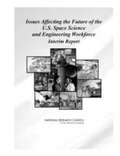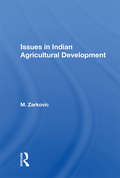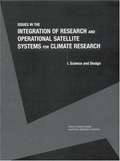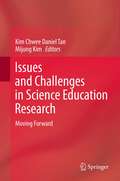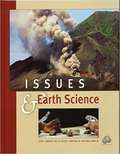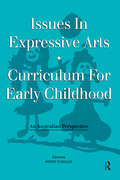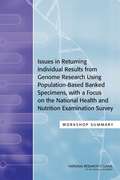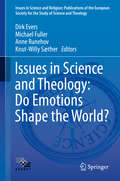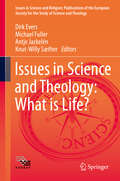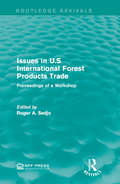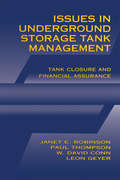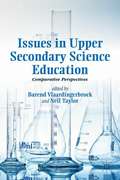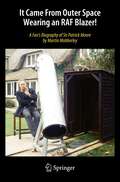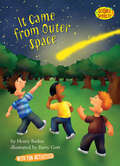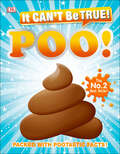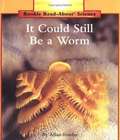- Table View
- List View
Issues & Physical Science
by University of California at Berkeley Lawrence Hall of ScienceNIMAC-sourced textbook
Issues Affecting the Future of the U.S. Space Science and Engineering Workforce: Interim Report
by National Research Council of the National AcademiesIn January 2006, the President announced a new civilian space policy focusing on exploration. As part of its preparations to implement that policy, NASA asked the NRC to explore long-range science and technology workforce needs to achieve the space exploration vision, identify obstacles to filling those needs, and put forward solutions to those obstacles. As part of the study, the NRC held a workshop to identify important factors affecting NASA’s future workforce and its capacity to implement the exploration vision. This interim report presents a summary of the highlights of that workshop and an initial set of findings. The report provides a review of the workforce implications of NASA’s plans, an assessment of science and technology workforce demographics, an analysis of factors affecting the aerospace workforce for both NASA and the relevant aerospace industry, and preliminary findings and recommendations. A final report is scheduled for completion in early 2007.
Issues In Indian Agricultural Development
by M. ZarkovicThis work analyzes growth and structural change in Indian agriculture over the last three decades. In order to develop a global perspective, the Indian agricultural growth experience is introduced using parallels and contrasts with other parts of the Third World. The book is characterized by an empirical approach to the underlying economic data and a multi-disciplinary approach to the ramifications of agricultural growth. Considered among these are the transformation of the female labor force, population migrations and changes in human welfare. This book differs from the numerous others on Indian agriculture insofar as it takes a regional perspective, focusing on the causes and effects of inter-state variations.
Issues In The Integration Of Research And Operational Satellite Systems For Climate Research: I. Science And Design
by National Research Council Space Studies BoardA report on the Issues In The Integration Of Research And Operational Satellite Systems For Climate Research
Issues and Challenges in Science Education Research
by Mijung Kim Kim Chwee TanIn contemporary society, science constitutes a significant part of human life in that it impacts on how people experience and understand the world and themselves. The rapid advances in science and technology, newly established societal and cultural norms and values, and changes in the climate and environment, as well as, the depletion of natural resources all greatly impact the lives of children and youths, and hence their ways of learning, viewing the world, experiencing phenomena around them and interacting with others. These changes challenge science educators to rethink the epistemology and pedagogy in science classrooms today as the practice of science education needs to be proactive and relevant to students and prepare them for life in the present and in the future. Featuring contributions from highly experienced and celebrated science educators, as well as research perspectives from Europe, the USA, Asia and Australia, this book addresses theoretical and practical examples in science education that, on the one hand, plays a key role in our understanding of the world, and yet, paradoxically, now acknowledges a growing number of uncertainties of knowledge about the world. The material is in four sections that cover the learning and teaching of science from science literacy to multiple representations; science teacher education; the use of innovations and new technologies in science teaching and learning; and science learning in informal settings including outdoor environmental learning activities. Acknowledging the issues and challenges in science education, this book hopes to generate collaborative discussions among scholars, researchers, and educators to develop critical and creative ways of science teaching to improve and enrich the lives of our children and youths.
Issues and Earth Science
by Janet BellantoniAs you examine the activities in this book, you may wonder, "Why does this book look so different from other science books I've seen?" The reason is simple: it is a different kind of science program, and only some of what you will learn can be seen by leafing through this book! Issues and Earth Science uses several kinds of activities to teach science. For example, you will observe and test the properties of soil, rocks, and minerals. You will examine a model of the way water moves earth materials to change the surface of the land. You will conduct a computer simulation to investigate the causes of earthquakes and volcanoes. You will also analyze data about Earth and the solar system. A combination of experiments, readings, models, debates, role plays, and projects will help you uncover the nature of science and the relevance of science to your interests. You will find that important scientific ideas come up again and again in different activities throughout the book. You will be expected to do more than just memorize these concepts: you will be asked to explain and apply them. In particular, you will improve your decision-making skills by using evidence to weigh outcomes and to decide what you think should be done about the scientific issues facing our society. How do we know that this is a good way for you to learn? In general, research on science education supports it. In particular, the activities in this book were tested by hundreds of students and their teachers, and then modified on the basis of their feedback. In a sense, this entire book is the result of an investigation: we had people test our ideas, we interpreted the results, and we then revised our ideas! We believe the result will show you that learning more about science is important, enjoyable, and relevant to your life.
Issues and Earth Science
by University of California at Berkeley Lawrence Hall of ScienceIssues and Earth Science is a different kind of science program which uses several kinds of activities to teach science. The activities in this book were tested by hundreds of students and their teachers, and then modified on the basis of their feedback. This book is part of SEPUP's middle school science course sequence.
Issues and Life Science
by Barbara Nagle Manisha Hariani Donna MarkeyAs you examine the activities in this book, you may wonder, "Why does this book look so different from other science books I've seen?" The reason is simple: it is a different kind of science program, and only some of what you will learn can be seen by leafing through this book!
Issues and Life Science, 2nd Edition
by SEPUP Lawrence Hall of Science University of California at BerkeleyScience textbook
Issues and Life Science: Ecology
by University of California at Berkeley Lawrence Hall of ScienceNIMAC-sourced textbook
Issues and Physical Science
by University of California at Berkeley Lawrence Hall of ScienceAs a different kind of science program, Issues and Physical Science uses several kinds of activities to teach science.
Issues and Physical Science (2nd Edition)
by University of CalIssues and Physical Science uses several kinds of activities to teach science. For example, you will observe and test the properties of elements and compounds. You will model the atoms and molecules that make up these substances. You will design and conduct investigations to explore energy transfer. You will investigate the motion of a cart on a ramp, and apply what you learn to the physics of automobile accidents and safety features. A combination of laboratories, investigations, readings, models, debates, role plays, and projects will help you uncover the nature of science and the relevance of physical science to your interests.
Issues and Physical Science: Force and Motion
by University of California at Berkeley Lawrence Hall of ScienceNIMAC-sourced textbook
Issues in Expressive Arts Curriculum for Early Childhood
by Craig A. SchillerPresents an Australian perspective on the issues in expressive arts in early childhood education by authors who are researching, teaching and actively involved in the arts as theatre directors, painter designers, adjudicators, advisers, actors or arts administrators in community organizations at the national and international level. It constitutes a collective look at the arts and young children. This volume covers a wide spectrum of arts areas, including the roles of the teacher as co-worker, collaborator, guide, facilitator and stage-manager; the tertiary educator in indigenous art, improvizational drama, and movement and dance; and the early childhood adviser in national, non-commercial television production. In addition, there is discussion on the national broadcasting standards required for children's commercial television production in Australia, the value of language and literature in the lives of young children and experimental programmes for theatre companies and symphony orchestras.
Issues in Returning Individual Results from Genome Research Using Population-Based Banked Specimens, with a Focus on the National Health and Nutrition Examination Survey: A Workshop Summary
by Kevin KinsellaPopulation surveys traditionally collect information from respondents about their circumstances, behaviors, attitudes, and other characteristics. In recent years, many surveys have been collecting not only questionnaire answers, but also biologic specimens such as blood samples, saliva, and buccal swabs, from which a respondent's DNA can be ascertained along with other biomarkers (e. g. , the level of a certain protein in the blood). The National Health and Nutrition Examination Survey (NHANES), sponsored by the National Center for Health Statistics (NCHS), has been collecting and storing genetic specimens since 1991, and other surveys, such as the Health and Retirement Study (HRS) funded by the National Institute on Aging, have followed suit. In order to give their informed consent to participate in a survey, respondents need to know the disposition and use of their data. Will their data be used for one research project and then destroyed, or will they be archived for secondary use? Sponsors of repeated cross-sectional surveys, such as NHANES, and of longitudinal surveys that follow panels of individuals over time, such as HRS, generally want to retain data for a wide range of secondary uses, many of which are not explicitly foreseen at the time of data collection. They typically inform respondents that their data will be stored in a secure manner and may be provided to researchers with suitable protections against individual identification. The addition of biologic specimens to a survey adds complications for storing, protecting, and providing access to such data and measurements made from them. There are also questions of whether, when, and for which biologic measurements the results should be reported back to individual respondents. Recently, the cost of full genomic sequencing has plummeted, and research findings are beginning to accumulate that bear up under replication and that potentially have clinical implications for a respondent. For example, knowing that one possesses a certain gene or gene sequence might suggest that one should seek a certain kind of treatment or genetic counseling or inform one's blood relatives. Biomedical research studies, in which participants are asked to donate tissues for genetic studies and are usually told that they will not be contacted with any results, are increasingly confronting the issue of when and which DNA results to return to participants. Issues in Returning Individual Results from Genome Research Using Population-Based Banked Specimens, with a Focus on the National Health and Nutrition Examination Survey is the summary of a workshop convened in February 2013 by the Committee on National Statistics in the Division of Behavioral and Social Sciences and Education of the National Research Council. This report considers how population surveys, in particular NHANES, should implement the reporting of results from genomic research using stored specimens and address informed consent for future data collection as well as for the use of banked specimens covered by prior informed consent agreements. The report will be of interest to survey organizations that include or contemplate including the collection of biologic specimens in population surveys for storing for genetic research. The issues involved are important for advancing social, behavioral, and biomedical knowledge while appropriately respecting and protecting individual survey respondents.
Issues in Science and Theology: Do Emotions Shape the World?
by Dirk Evers Michael Fuller Anne Runehov Knut-Willy SætherThis volume examines emotions andemotional well-being from a rich variety of theological, philosophical andscientific and therapeutic perspectives. To experience emotion is a part ofbeing human; but what are emotions? How can theology, philosophy and thenatural sciences unpack the nature and content of emotions? This volume is based on contributions to the15th European Conference on Science and Theology held in Assisi, Italy. Itbrings together contributions from scholars of various academic backgrounds from around the world, whose individual insights are made all the richer bytheir juxtaposition with those from experts in other fields, leading to aunique exchange of ideas.
Issues in Science and Theology: What is Life?
by Dirk Evers Michael Fuller Knut-Willy Sæther Antje JackelénThis book explores the concept of Life from a range of perspectives. Divided into three parts, it first examines the concept of Life from physics to biology. It then presents insights on the concept from the perspectives of philosophy, theology, and ethics. The book concludes with chapters on the hermeneutics of Life, and pays special attention to the Biosemiotics approach to the concept. The question 'What is Life?' has been deliberated by the greatest minds throughout human history. Life as we know it is not a substance or fundamental property, but a complex process. It is not an easy task to develop an unequivocal approach towards Life combining scientific, semiotic, philosophical, theological, and ethical perspectives. In its combination of these perspectives, and its wide-ranging scope, this book opens up levels and identifies issues which can serve as intersections for meaningful interdisciplinary discussions of Life in its different aspects. The book includes the four plenary lectures and selected, revised and extended papers from workshops of the 14th European Conference on Science and Theology (ECST XIV) held in Tartu, Estonia, April 2012.
Issues in U.S International Forest Products Trade: Proceedings of a Workshop (Routledge Revivals)
by Roger A. SedjoAfter World War two, the United States became integrates into the world forest economy however the complexity of their trade agreements introduced several issues which needed to be addressed by world forestry policy. Originally published in 1981, this study delves into important issues related to forest resources and trade such as the future role of the United States in the world forest economy, trade restriction and U.S log exports. This title will be of interest to students of Environmental Studies and Economics.
Issues in Underground Storage Tank Management UST Closure and Financial Assurance
by Janet E. Robinson Paul S. Thompson W. David Conn L. Leon GeyerIssues in Underground Storage Tank Management presents a comprehensive description of the many complex facets of hazardous waste management, tank closure, and site assessment. It is also the only book to cover financial assurance of UST remediation. Part I discusses UST closure including regulation, closure techniques, site assessment methods and d
Issues in Upper Secondary Science Education: Comparative Perspectives
by Barend VlaardingerbroekThis book provides a comparative look at key issues that characterize and contextualize upper secondary science education in sixteen countries in Oceania, South America, Asia, Europe, North America, Africa, and the Middle East, incluing links with elementary and early science, final assessment, and the secondary/tertiary education interface.
Issues, Evidence and You Student Book
by Lawrence Hall of Science SepupIssues, Evidence and You (IEY) uses several kinds of activities to teach science. For example, you will design and conduct an experiment to determine the amount of acid in simulated industrial waste water. You will investigate the chemical and physical properties of plastics and other common materials. And you will apply what you have learned about energy and materials to design an energy-efficient car.
It Came From Outer Space Wearing an RAF Blazer!: A Fan's Biography of Sir Patrick Moore
by Martin MobberleyTo British television viewers, the name 'Patrick Moore' has been synonymous with Astronomy and Space Travel since he first appeared on The Sky at Night in 1957. To amateur astronomers he has been a source of inspiration, joy, humour and even an eccentric role model since that time. Most people know that his 55 years of presenting The Sky at Night is a world record, but what was he really like in person? What did he do away from the TV cameras, in his observatory, and within the British Astronomical Association, the organisation that inspired him as a youngster? Also, precisely what did he do during the War Years, a subject that has always been shrouded in mystery? Martin Mobberley, a friend of Patrick Moore's for 30 years, and a former President of the British Astronomical Association, has spent ten years exhaustively researching Patrick's real life away from the TV cameras. His childhood, RAF service, tireless voluntary work for astronomy and charity and his endless book writing are all examined in detail. His astronomical observations are also examined in unprecedented detail, along with the battles he fought along the way and his hatred of bureaucracy and political correctness. No fan of Sir Patrick Moore can possibly live without this work on their bookshelf!
It Came from Outer Space (Science Solves It!)
by Henry BarkerSolve kid-sized dilemmas and mysteries with the Science Solves It! series. These fun books for kids ages 5–8 blend clever stories with real-life science. Why did the dog turn green? Can you control a hiccup? Is that a UFO? Find the answers to these questions and more as kid characters dive into physical, life, and earth sciences. During a camp out, Marlon and his friends see a bright light streak across the sky. Is it a meteorite? A spaceship? Have aliens landed? Books in this perfect STEM series will help kids think like scientists and get ahead in the classroom. Activities and experiments are included in every book! (Level Two; Science topic: Space detritus)
It Can't Be True! Poo: Packed with Pootastic Facts (DK 1,000 Amazing Facts)
by DKThis book stinks!Hold your nose while you find out absolutely everything you never knew about poo! Did you know that..A week's worth of elephant poo weighs as much a 25 people?A lifetime of farts would fill 2,000 balloons?The world uses enough toilet paper in an hour to wrap around the Earth 14 times?This irresistibly disgusting book for children will teach you all you need to know about all kinds of animal dung and human waste - what it's for, how it's made, where it goes, and lots more! Poo comes in all shapes and sizes. Every animal has its own special sort and some have fascinating uses for it. Wombats use their cube-shaped droppings to mark their territory; potato beetles build a shield of dung for defense; male hippos spray out a fecal shower to attract mates; and rabbits and dung beetles eat their pellets for extra nutrition. We might call it "waste" but in fact, poo is among the most useful stuff on Earth. From building materials and paper to coffee and even water purification, there's a multitude of manure-based matter in our lives.This unique book is jam-packed with scientific explanations and amazing trivia about human and animal deposits. Did you know, for example, that the global population produces more than a million tons of poo every day? Or that an average poo contains 10 trillion bacteria? Or that wars have been fought over guano? All these facts and more are presented, either with jaw-dropping CGI illustrations or eye-popping photography. Additional boxes feature infographics that make information easy to understand. With endlessly interesting information and incredible visuals, It Can't Be True! Poo is the perfect way to entertain and amuse your friends, family, and yourself. In fact, you'll never look at poo in the same way again!"
It Could Still Be A Worm
by Allan FowlerFrom friendly dolphins to giant pandas, from icebergs and glaciers to energy from the sun, from magnets to solids, liquids, and gases, Rookie Read-About Science is a natural addition to the primary-grade classroom with books that cover every part of the science curricula. Includes: animals, nature, scientific principles, the environment, weather, and much more!

